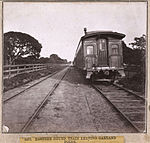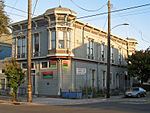Oakland Army Base

The Oakland Army Base, also known as the Oakland Army Terminal, is a decommissioned United States Army base in the San Francisco Bay Area of California. The base was located at the Port of Oakland on Maritime Street just south of the eastern entrance to the San Francisco–Oakland Bay Bridge.Construction of the base commenced in 1941 as a part of the expanding San Francisco Port of Embarkation which was headquartered at Fort Mason on the San Francisco waterfront. Initially named the Oakland Sub-Port of the San Francisco Port of Embarkation, the base was renamed the Oakland Army Base in 1944. The installation moved in excess of 8.5 million tons of cargo during World War II, and 7.2 million tons of cargo passed through the terminal during the Korean War.In 1946, the Oakland Army Base expanded to incorporate the administrative and cantonment area of the Port formerly known as Camp John T. Knight in honor of World War I Brigadier General John Thornton Knight.In 1955 the San Francisco Port of Embarkation became the U.S. Army Transportation Terminal Command Pacific, and the Oakland Army Base became the Oakland Army Terminal. In 1964 the headquarters of the command moved from Fort Mason to the Oakland Army Terminal, and in 1966 the terminal was renamed back to the Oakland Army Base. During the Vietnam War, Oakland Army Base served as a major transit station for U.S. soldiers en route to and returning from all deployment locations in East Asia—such as Vietnam and Korea. The base decommissioned on September 30, 1999.In 2007, the Oral History Center of The Bancroft Library at the University of California, Berkeley, in partnership with the City of Oakland and the Port of Oakland, commenced a comprehensive oral history project documenting the history of the Base from when it was commissioned in 1941 to when it was shut down in 1999, and thereafter.
Excerpt from the Wikipedia article Oakland Army Base (License: CC BY-SA 3.0, Authors, Images).Oakland Army Base
Tulagi Street, Oakland
Geographical coordinates (GPS) Address Nearby Places Show on map
Geographical coordinates (GPS)
| Latitude | Longitude |
|---|---|
| N 37.816666666667 ° | E -122.30055555556 ° |
Address
Tulagi Street
Tulagi Street
94608 Oakland
California, United States
Open on Google Maps





